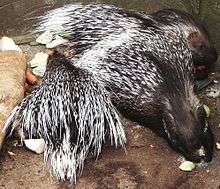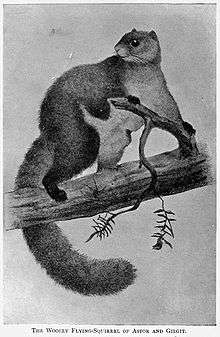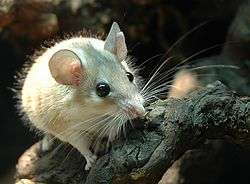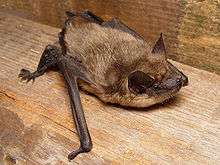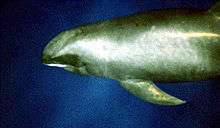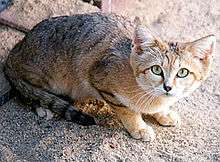List of mammals of Pakistan
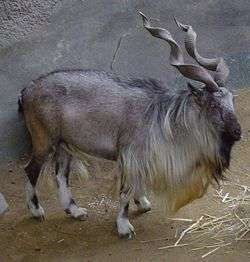

| Part of a series on |
| Wildlife of Pakistan |
|---|
 |
|
Biodiversity Fauna and Flora
|
|
Conservation Protected areas
|
|
Organizations National
Ministry of Environment (Pakistan) · Pakistan Environmental Protection Agency · Dhodial Pheasantry · Zoological Survey Department of Pakistan · Sindh Wildlife Department · Punjab Wildlife Department · Khyber Pakhtukhwa Wildlife Department · Baluchistan Wildlife Department · Gilgit Baltistan Wildlife Department · Himalayan Wildlife Foundation · National Institute of Oceanography (Pakistan) International
|
|
Related topics Ecoregions · Forestry · Fishing Agriculture · Tourism Botanical and Zoological gardens Environmental issues |
This is a list of the mammal species recorded in Pakistan. There are 173 mammal species in Pakistan, of which 0 are critically endangered, 9 are endangered, 14 are vulnerable, and 7 are near-threatened. The largest mammal in Pakistan is the Asiatic brown bear. Capra falconeri is the national animal of Pakistan.[1]
The following tags are used to highlight each species' conservation status as assessed by the IUCN:
| EX | Extinct | No reasonable doubt that the last individual has died. |
| EW | Extinct in the wild | Known only to survive in captivity or as a naturalized populations well outside its previous range. |
| CR | Critically endangered | The species is in imminent risk of extinction in the wild. |
| EN | Endangered | The species is facing an extremely high risk of extinction in the wild. |
| VU | Vulnerable | The species is facing a high risk of extinction in the wild. |
| NT | Near threatened | The species does not meet any of the criteria that would categorise it as risking extinction but it is likely to do so in the future. |
| LC | Least concern | There are no current identifiable risks to the species. |
| DD | Data deficient | There is inadequate information to make an assessment of the risks to this species. |
Some species were assessed using an earlier set of criteria. Species assessed using this system have the following instead of near threatened and least concern categories:
| LR/cd | Lower risk/conservation dependent | Species which were the focus of conservation programmes and may have moved into a higher risk category if that programme was discontinued. |
| LR/nt | Lower risk/near threatened | Species which are close to being classified as vulnerable but are not the subject of conservation programmes. |
| LR/lc | Lower risk/least concern | Species for which there are no identifiable risks. |
Subclass: Theria
Infraclass: Eutheria
Order: Proboscidea (elephants)
The elephants comprise three living species and are the largest living land animals.
- Family: Elephantidae (elephants)
- Genus: Elephas
- Species: Asian elephant Elephas maximus EN
- Indian elephant Elephas maximus indicus EN - (Extirpated)
- Species: Asian elephant Elephas maximus EN
- Genus: Elephas
Order: Primates
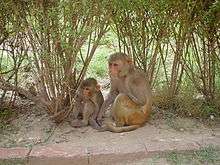
The order Primates contains humans and their closest relatives: lemurs, lorisoids, monkeys, and apes.
- Suborder: Haplorhini
- Infraorder: Simiiformes
- Parvorder: Catarrhini
- Superfamily: Cercopithecoidea
- Family: Cercopithecidae (Old World monkeys)
- Genus: Macaca
- Rhesus macaque Macaca mulatta LR/nt
- Subfamily: Colobinae
- Genus: Semnopithecus
- Gray langur Semnopithecus entellus LR/nt
- Genus: Semnopithecus
- Genus: Macaca
- Family: Cercopithecidae (Old World monkeys)
- Superfamily: Cercopithecoidea
- Parvorder: Catarrhini
- Infraorder: Simiiformes
Order: Rodentia (rodents)
Rodents make up the largest order of mammals, with over 40 percent of mammalian species. They have two incisors in the upper and lower jaw which grow continually and must be keep short by gnawing. Most rodents are small though the capybara can weigh up to 45 kg (100 lb).
- Suborder: Hystricognathi
- Family: Hystricidae (Old World porcupines)
- Genus: Hystrix
- Indian porcupine Hystrix indica LR/lc
- Genus: Hystrix
- Family: Hystricidae (Old World porcupines)
- Suborder: Sciurognathi
- Family: Sciuridae (squirrels)
- Subfamily: Sciurinae
- Tribe: Pteromyini
- Genus: Eoglaucomys
- Kashmir flying squirrel Eoglaucomys fimbriatus LC
- Genus: Eupetaurus
- Woolly flying squirrel Eupetaurus cinereus EN
- Genus: Petaurista
- Red giant flying squirrel Petaurista petaurista
- Genus: Eoglaucomys
- Tribe: Pteromyini
- Subfamily: Callosciurinae
- Genus: Funambulus
- Northern palm squirrel Funambulus pennantii LR/lc
- Genus: Funambulus
- Subfamily: Xerinae
- Tribe: Marmotini
- Genus: Marmota
- Long-tailed marmot Marmota caudata LR/nt
- Himalayan marmot Marmota himalayana LC
- Genus: Marmota
- Tribe: Marmotini
- Subfamily: Sciurinae
- Family: Gliridae (dormice)
- Subfamily: Leithiinae
- Genus: Dryomys
- Balochistan forest dormouse Dryomys niethammeri VU
- Forest dormouse Dryomys nitedula LR/nt
- Genus: Dryomys
- Subfamily: Leithiinae
- Family: Dipodidae (jerboas)
- Subfamily: Allactaginae
- Genus: Allactaga
- Small five-toed jerboa Allactaga elater LR/lc
- Hotson's jerboa Allactaga hotsoni LR/lc
- Genus: Allactaga
- Subfamily: Cardiocraniinae
- Genus: Salpingotus
- Baluchistan pygmy jerboa Salpingotus michaelis LR/lc
- Genus: Salpingotus
- Subfamily: Dipodinae
- Genus: Jaculus
- Blanford's jerboa Jaculus blanfordi LR/lc
- Genus: Jaculus
- Subfamily: Sicistinae
- Genus: Sicista
- Chinese birch mouse Sicista concolor LR/lc
- Genus: Sicista
- Subfamily: Allactaginae
- Family: Calomyscidae
- Genus: Calomyscus
- Baluchi mouse-like hamster Calomyscus baluchi LR/lc
- Hotson's mouse-like hamster Calomyscus hotsoni EN
- Genus: Calomyscus
- Family: Cricetidae
- Subfamily: Cricetinae
- Genus: Cricetulus
- Gray dwarf hamster Cricetulus migratorius LR/nt
- Genus: Cricetulus
- Subfamily: Arvicolinae
- Genus: Alticola
- White-tailed mountain vole Alticola albicauda LR/nt
- Silver mountain vole Alticola argentatus LR/lc
- Genus: Ellobius
- Southern mole vole Ellobius fuscocapillus LR/lc
- Genus: Hyperacrius
- True's vole Hyperacrius fertilis LR/lc
- Murree vole Hyperacrius wynnei LR/lc
- Genus: Microtus
- Juniper vole Microtus juldaschi LR/lc
- Genus: Alticola
- Subfamily: Cricetinae
- Family: Muridae (mice, rats, voles, gerbils, hamsters, etc.)
- Subfamily: Deomyinae
- Genus: Acomys
- Arabian spiny mouse Acomys dimidiatus LC
- Genus: Acomys
- Subfamily: Gerbillinae
- Genus: Gerbillus
- Swarthy gerbil Gerbillus aquilus LR/lc
- Indian hairy-footed gerbil Gerbillus gleadowi
- Balochistan gerbil Gerbillus nanus LC
- Genus: Meriones
- Indian desert jird Meriones hurrianae LR/lc
- Persian jird Meriones persicus LR/lc
- Libyan jird Meriones libycus LC
- Sundevall's jird Meriones crassus LC
- Genus: Rhombomys
- Great gerbil Rhombomys opimus LR/lc
- Genus: Tatera
- Indian gerbil Tatera indica LR/lc
- Genus: Gerbillus
- Subfamily: Murinae
- Genus: Apodemus
- Kashmir field mouse Apodemus rusiges LR/lc
- Ward's field mouse Apodemus wardi LR/lc
- Genus: Bandicota
- Lesser bandicoot rat Bandicota bengalensis LR/lc
- Genus: Golunda
- Indian bush rat Golunda ellioti LR/lc
- Genus: Millardia
- Sand-colored soft-furred rat Millardia gleadowi LR/lc
- Soft-furred rat Millardia meltada LC
- Genus: Mus
- Rock-loving mouse Mus saxicola LR/lc
- Earth-colored mouse Mus terricolor LR/lc
- House mouse Mus musculus LC
- Brown spiny mouse Mus saxicola LR/lc
- Genus: Nesokia
- Short-tailed bandicoot rat Nesokia indica LC
- Genus: Niviventer
- Chestnut white-bellied rat Niviventer fulvescens LR/lc
- Genus: Rattus
- Turkestan rat Rattus turkestanicus LR/lc
- House rat Rattus rattus LC
- Brown rat Rattus norvegicus LC
- Genus: Apodemus
- Subfamily: Deomyinae
- Family: Sciuridae (squirrels)
Order: Lagomorpha (lagomorphs)
The lagomorphs comprise two families, Leporidae (hares and rabbits), and Ochotonidae (pikas). Though they can resemble rodents, and were classified as a superfamily in that order until the early 20th century, they have since been considered a separate order. They differ from rodents in a number of physical characteristics, such as having four incisors in the upper jaw rather than two.
- Family: Ochotonidae (pikas)
- Genus: Ochotona
- Ladakh pika Ochotona ladacensis LR/lc
- Black-lipped pika Ochotona curzoniae LR/lc
- Large-eared pika Ochotona macrotis LR/lc
- Nubra pika Ochotona nubrica LR/lc
- Royle's pika Ochotona roylei LR/lc
- Afghan pika Ochotona rufescens LR/lc
- Genus: Ochotona
- Family: Leporidae (rabbits, hares)
- Genus: Lepus
- Indian hare Lepus nigricollis LR/lc
- Woolly hare Lepus oiostolus LR/lc
- Cape hare Lepus capensis LC
- Genus: Lepus
Order: Erinaceomorpha (hedgehogs and gymnures)
The order Erinaceomorpha contains a single family, Erinaceidae, which comprise the hedgehogs and gymnures. The hedgehogs are easily recognised by their spines while gymnures look more like large rats.
- Family: Erinaceidae (hedgehogs)
- Subfamily: Erinaceinae
- Genus: Hemiechinus
- Long-eared hedgehog Hemiechinus auritus LR/lc
- Indian long-eared hedgehog Hemiechinus collaris LR/lc
- Brandt's hedgehog Hemiechinus hypomelas LR/lc
- Indian hedgehog Hemiechinus micropus LR/lc
- Genus: Hemiechinus
- Subfamily: Erinaceinae
Order: Soricomorpha (shrews, moles, and solenodons)
The "shrew-forms" are insectivorous mammals. The shrews and solenodons closely resemble mice while the moles are stout-bodied burrowers.
- Family: Soricidae (shrews)
- Subfamily: Crocidurinae
- Genus: Crocidura
- Gmelin's white-toothed shrew Crocidura gmelini LR/lc
- Pale gray shrew Crocidura pergrisea DD
- Zarudny's shrew Crocidura zarudnyi LR/lc
- Asian gray shrew Crocidura suaveolens
- Genus: Suncus
- Etruscan shrew Suncus etruscus LC
- Asian house shrew Suncus murinus LR/lc
- Anderson's shrew Suncus stoliczkanus LR/lc
- Genus: Crocidura
- Subfamily: Soricinae
- Tribe: Soricini
- Genus: Sorex
- Kashmir shrew Sorex planiceps LR/lc
- Genus: Sorex
- Tribe: Soricini
- Subfamily: Crocidurinae
Order: Chiroptera (bats)
The bats' most distinguishing feature is that their forelimbs are developed as wings, making them the only mammals in the world naturally capable of flight. Bat species account for about 20% of all mammals.
- Family: Pteropodidae (flying foxes, Old World fruit bats)
- Subfamily: Pteropodinae
- Genus: Pteropus
- Indian flying-fox Pteropus giganteus LR/lc
- Genus: Rousettus
- Egyptian fruit bat Rousettus aegyptiacus LC
- Leschenault's rousetteLRousettus leschenaultii R/lc
- Genus: Pteropus
- Subfamily: Pteropodinae
- Family: Vespertilionidae
- Subfamily: Myotinae
- Genus: Myotis
- Lesser mouse-eared bat Myotis blythii LR/lc
- Whiskered myotis Myotis muricola LR/lc
- Geoffroy's bat Myotis emarginatus LC
- Kashmir cave bat Myotis longipes DD
- Genus: Myotis
- Subfamily: Vespertilioninae
- Genus: Barbastella
- Eastern barbastelle Barbastella leucomelas LR/lc
- Genus: Eptesicus
- Botta's serotine Eptesicus bottae LC
- Gobi big brown bat Eptesicus gobiensis LR/lc
- Sind bat Eptesicus nasutus VU
- Serotine Eptesicus serotinus LC
- Genus: Nyctalus
- Lesser noctule Nyctalus leisleri LR/nt
- Mountain noctule Nyctalus montanus LR/nt
- Common noctule Nyctalus noctula LR/lc
- Genus: Otonycteris
- Desert long-eared bat Otonycteris hemprichii LR/lc
- Genus: Pipistrellus
- Kelaart's pipistrelle Pipistrellus ceylonicus LR/lc
- Indian pipistrelle Pipistrellus coromandra LR/lc
- Java pipistrelle Pipistrellus javanicus LR/lc
- Kuhl's pipistrelle Pipistrellus kuhlii LC
- Common pipistrelle Pipistrellus pipistrellus LC
- Least pipistrelle Pipistrellus tenuis LR/lc
- Savi's pipistrelle Pipistrellus savii
- Genus: Scotoecus
- Desert yellow bat Scotoecus pallidus NT
- Genus: Scotophilus
- Greater Asiatic yellow bat Scotophilus heathi LR/lc
- Lesser Asiatic yellow bat Scotophilus kuhlii LR/lc
- Genus: Scotozous
- Dormer's pipistrelle Scotozous dormeri LC
- Genus: Barbastella
- Subfamily: Murininae
- Genus: Murina
- Hutton's tube-nosed bat Murina huttoni LR/nt
- Scully's tube-nosed bat Murina tubinaris LR/lc
- Genus: Murina
- Subfamily: Myotinae
- Family: Rhinopomatidae
- Genus: Rhinopoma
- Lesser mouse-tailed bat Rhinopoma hardwickei LC
- Greater mouse-tailed bat Rhinopoma microphyllum LC
- Small mouse-tailed bat Rhinopoma muscatellum LC
- Genus: Rhinopoma
- Family: Emballonuridae
- Genus: Taphozous
- Naked-rumped tomb bat Taphozous nudiventris LC
- Egyptian tomb bat Taphozous perforatus LC
- Genus: Taphozous
- Family: Megadermatidae
- Genus: Megaderma
- Indian false vampire bat Megaderma lyra LC
- Genus: Megaderma
- Family: Rhinolophidae
- Subfamily: Rhinolophinae
- Genus: Rhinolophus
- Blasius's horseshoe bat Rhinolophus blasii NT
- Greater horseshoe bat Rhinolophus ferrumequinum LR/nt
- Lesser horseshoe bat Rhinolophus hipposideros LC
- Blyth's horseshoe bat Rhinolophus lepidus LR/lc
- Big-eared horseshoe bat Rhinolophus macrotis LR/lc
- Genus: Rhinolophus
- Subfamily: Hipposiderinae
- Genus: Asellia
- Trident leaf-nosed bat Asellia tridens LC
- Genus: Hipposideros
- Ashy roundleaf bat Hipposideros cineraceus LR/lc
- Fulvus roundleaf bat Hipposideros fulvus LR/lc
- Genus: Triaenops
- Persian trident bat Triaenops persicus LC
- Genus: Asellia
- Subfamily: Rhinolophinae
- Family: Molossidae
- Genus: Tadarida
- Egyptian free-tailed bat Tadarida aegyptiaca LC
- Genus: Tadarida
Order: Pholidota (pangolins)
The order Philodota comprises the eight species of pangolin. Pangolins are anteaters and have the powerful claws, elongated snout and long tongue seen in the other unrelated anteater species.
- Family: Manidae
- Genus: Manis
- Indian pangolin Manis crassicaudata LR/nt
- Genus: Manis
Order: Cetacea (whales)

The order Cetacea includes whales, dolphins and porpoises. They are the mammals most fully adapted to aquatic life with a spindle-shaped nearly hairless body, protected by a thick layer of blubber, and forelimbs and tail modified to provide propulsion underwater.
- Suborder: Mysticeti
- Family: Balaenopteridae
- Subfamily: Balaenopterinae
- Genus: Balaenoptera
- Bryde's whale Balaenoptera edeni DD
- Pygmy blue whale Balaenoptera musculus brevicauda EN
- Fin whale Balaenoptera physalus EN
- Genus: Balaenoptera
- Subfamily: Megapterinae
- Genus: Megaptera
- Humpback whale Megaptera novaeangliae VU (World's most isolated, most endangered, and only non-migratory population[2])
- Genus: Megaptera
- Subfamily: Balaenopterinae
- Family: Balaenopteridae
- Suborder: Odontoceti
- Superfamily: Platanistoidea
- Family: Platanistidae
- Genus: Platanista
- Indus river dolphin (national marine mammal of Pakistan) Platanista minor minor EN
- Genus: Platanista
- Family: Phocoenidae
- Genus: Neophocaena
- Finless porpoise Neophocaena phocaenoides DD
- Genus: Neophocaena
- Family: Kogiidae
- Genus: Kogia
- Pygmy sperm whale Kogia breviceps LR/lc
- Dwarf sperm whale Kogia sima LR/lc
- Genus: Kogia
- Family: Ziphidae
- Subfamily: Hyperoodontinae
- Genus: Mesoplodon
- Blainville's beaked whale Mesoplodon densirostris DD
- Ginkgo-toothed beaked whale Mesoplodon ginkgodens DD
- Genus: Mesoplodon
- Subfamily: Hyperoodontinae
- Family: Delphinidae (marine dolphins)
- Genus: Steno
- Rough-toothed dolphin Steno bredanensis DD
- Genus: Sousa
- Genus: Tursiops
- Bottlenose dolphin Tursiops aduncus DD
- Bottlenose dolphin Tursiops truncatus DD
- Genus: Stenella
- Spinner dolphin Stenella longirostris LR/cd
- Genus: Delphinus
- Common dolphin Delphinus capensis LR/lc
- Genus: Lagenodelphis
- Fraser's dolphin Lagenodelphis hosei DD
- Genus: Grampus
- Risso's dolphin Grampus griseus DD
- Genus: Peponocephala
- Melon-headed whale Peponocephala electra LR/lc
- Genus: Feresa
- Pygmy killer whale Feresa attenuata DD
- Genus: Steno
- Family: Platanistidae
- Superfamily: Platanistoidea
Order: Carnivora (carnivorans)
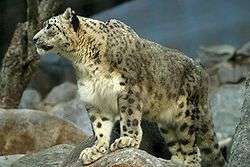
There are over 260 species of carnivorans, the majority of which eat meat as their primary dietary item. They have a characteristic skull shape and dentition.
- Suborder: Feliformia
- Family: Felidae (cats)
- Subfamily: Felinae
- Genus: Acinonyx
- Asiatic cheetah Acinonyx jubatus venaticus CR - (Extirpated)
- Genus: Caracal
- Caracal Caracal caracal LC
- Genus: Felis
- Himalayan jungle cat Felis chaus affinis LC
- Bengal jungle cat Felis chaus kutas LC
- Thar jungle cat Felis chaus prateri LC
- Pakistan sand cat Felis margarita scheffeli CR
- Asiatic wildcat Felis silvestris ornata LC
- Genus: Otocolobus
- Pallas's cat Otocolobus manul NT
- Genus: Lynx
- Turkestan lynx Lynx lynx isabellinus LC
- Genus: Prionailurus
- Leopard cat Prionailurus bengalensis LC
- Fishing cat Prionailurus viverrinus VU
- Genus: Acinonyx
- Subfamily: Pantherinae
- Genus: Panthera
- Asiatic lion Panthera leo persica EN - (Extirpated)
- Indian leopard Panthera pardus fusca NT
- Persian leopard Panthera pardus ciscaucasica EN
- Bengal tiger Panthera tigris tigris EN - (Extirpated)
- Genus: Uncia
- Snow leopard (national predator of Pakistan) Uncia uncia - EN
- Genus: Panthera
- Subfamily: Felinae
- Family: Viverridae (civets, mongooses, etc.)
- Subfamily: Paradoxurinae
- Genus: Paguma
- Masked palm civet Paguma larvata LR/lc
- Genus: Paguma
- Subfamily: Viverrinae
- Genus: Viverricula
- Small Indian civet Viverricula indica LR/lc
- Genus: Viverricula
- Subfamily: Paradoxurinae
- Family: Herpestidae (mongooses)
- Genus: Herpestes
- Indian gray mongoose Herpestes edwardsii LR/lc
- Small Asian mongoose Herpestes javanicus LR/lc
- Genus: Herpestes
- Family: Hyaenidae (hyaenas)
- Genus: Hyaena
- Striped hyena Hyaena hyaena LR/nt
- Genus: Hyaena
- Family: Felidae (cats)
- Suborder: Caniformia
- Family: Canidae (dogs, foxes)
- Genus: Vulpes
- Blanford's fox Vulpes cana VU
- Red fox Vulpes vulpes LC
- Bengal fox Vulpes bengalensis LC
- Rüppell's fox Vulpes rueppellii LC
- Genus: Canis
- Common jackal Canis aureus aureus LC
- Indian wolf Canis lupus pallipes EN
- Genus: Cuon
- Tien Shan dhole Cuon alpinus hesperius EN
- Genus: Vulpes
- Family: Ursidae (bears)
- Genus: Ursus
- Himalayan brown bear Ursus arctos isabellinus CR
- Asiatic black bear Ursus thibetanus VU
- Genus: Ursus
- Family: Mustelidae (mustelids)
- Genus: Mustela
- Stoat Mustela erminea LR/lc
- Mountain weasel Mustela altaica NT
- Genus: Vormela
- Marbled polecat Vormela peregusna LR/lc
- Genus: Martes
- Yellow-throated marten Martes flavigula LR/lc
- Beech marten Martes foina LR/lc
- Genus: Mellivora
- Ratel Mellivora capensis LR/lc
- Genus: Lutra
- European otter Lutra lutra NT
- Genus: Lutrogale
- Smooth-coated otter Lutrogale perspicillata VU
- Genus: Mustela
- Family: Canidae (dogs, foxes)
Order: Perissodactyla (odd-toed ungulates)
The odd-toed ungulates are browsing and grazing mammals. They are usually large to very large, and have relatively simple stomachs and a large middle toe.
- Family: Equidae (horses etc.)
- Genus: Equus
- Indian wild ass Equus hemionus khur NT
- Persian onager Equus hemionus onager EN - (Extirpated)
- Genus: Equus
- Family: Rhinocerotidae
- Genus: Rhinoceros
- Indian rhinoceros Rhinoceros unicornis VU - (Extirpated)
- Genus: Rhinoceros
Order: Artiodactyla (even-toed ungulates)

The even-toed ungulates are ungulates whose weight is borne about equally by the third and fourth toes, rather than mostly or entirely by the third as in perissodactyls. There are about 220 artiodactyl species, including many that are of great economic importance to humans.
- Family: Suidae (pigs)
- Family: Moschidae
- Genus: Moschus
- Himalayan musk deer Moschus chrysogaster LR/nt
- Genus: Moschus
- Family: Cervidae (deer)
- Subfamily: Cervinae
- Genus: Rucervus
- Barasingha Rucervus duvaucelii VU - (Extirpated)
- Genus: Axis
- Spotted deer Axis axis LC - (Extirpated)
- Genus: Hyelaphus
- Indian hog deer Hyelaphus porcinus EN
- Genus: Muntiacus
- Barking deer Muntiacus muntjak
- Genus: Rucervus
- Subfamily: Cervinae
- Family: Bovidae (cattle, antelope, sheep, goats)
- Subfamily: Antilopinae
- Genus: Antilope
- Blackbuck (provincial animal of Punjab (Pakistan) Antilope cervicapra NT
- Genus: Gazella
- Chinkara Gazella bennettii LC
- Goitered gazelle Gazella subgutturosa VU
- Genus: Antilope
- Subfamily: Bovinae
- Genus: Boselaphus
- Nilgai Boselaphus tragocamelus LC
- Genus: Boselaphus
- Subfamily: Caprinae
- Genus: Capra
- Wild goat Capra aegagrus VU
- Markhor (National animal of Pakistan) Capra falconeri EN
- Siberian ibex Capra sibrica LR/lc
- Genus: Nemorhaedus
- Grey goral Nemorhaedus goral LR/nt
- Genus: Ovis
- Marco Polo sheep Ovis ammon polii LR/nt
- Urial Ovis orientalis vignei VU
- Genus: Pseudois
- Bharal Pseudois nayaur LC
- Genus: Capra
- Subfamily: Antilopinae
See also
- List of chordate orders
- List of regional mammals lists
- List of prehistoric mammals
- Mammal classification
- New mammal species
Notes
- ↑ This list is derived from the IUCN Red List which lists species of mammals and includes those mammals that have recently been classified as extinct (since 1500 AD). The taxonomy and naming of the individual species is based on those used in existing Wikipedia articles as of 21 May 2007 and supplemented by the common names and taxonomy from the IUCN, Smithsonian Institution, or University of Michigan where no Wikipedia article was available.
- ↑ http://www.iucnredlist.org/details/132835/0
| Wikimedia Commons has media related to Mammals of Pakistan. |
References
- "The IUCN Red List of Threatened Species: Mammals of Pakistan". IUCN. 2001. Retrieved 22 May 2007.
- "Mammal Species of the World". Smithsonian National Museum of Natural History. 2005. Archived from the original on 27 April 2007. Retrieved 22 May 2007.
- "Animal Diversity Web". University of Michigan Museum of Zoology. 1995–2006. Retrieved 22 May 2007.
